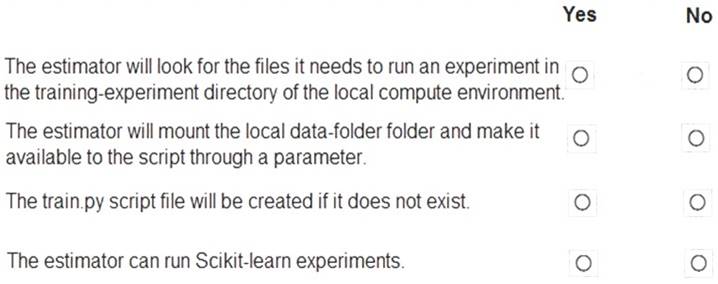- (Exam Topic 3)
HOTSPOT
You create a script for training a machine learning model in Azure Machine Learning service. You create an estimator by running the following code:
For each of the following statements, select Yes if the statement is true. Otherwise, select No.
NOTE: Each correct selection is worth one point.
Solution:
Box 1: Yes
Parameter source_directory is a local directory containing experiment configuration and code files needed for a training job.
Box 2: Yes
script_params is a dictionary of command-line arguments to pass to the training script specified in entry_script.
Box 3: No
Box 4: Yes
The conda_packages parameter is a list of strings representing conda packages to be added to the Python environment for the experiment.
Does this meet the goal?
Correct Answer:
A
- (Exam Topic 3)
You train a model and register it in your Azure Machine Learning workspace. You are ready to deploy the model as a real-time web service.
You deploy the model to an Azure Kubernetes Service (AKS) inference cluster, but the deployment fails because an error occurs when the service runs the entry script that is associated with the model deployment.
You need to debug the error by iteratively modifying the code and reloading the service, without requiring a re-deployment of the service for each code update.
What should you do?
Correct Answer:
C
How to work around or solve common Docker deployment errors with Azure Container Instances (ACI) and Azure Kubernetes Service (AKS) using Azure Machine Learning.
The recommended and the most up to date approach for model deployment is via the Model.deploy() API using an Environment object as an input parameter. In this case our service will create a base docker image for you during deployment stage and mount the required models all in one call. The basic deployment tasks are:
* 1. Register the model in the workspace model registry.
* 2. Define Inference Configuration:
* a. Create an Environment object based on the dependencies you specify in the environment yaml file or use one of our procured environments.
* b. Create an inference configuration (InferenceConfig object) based on the environment and the scoring script.
* 3. Deploy the model to Azure Container Instance (ACI) service or to Azure Kubernetes Service (AKS).